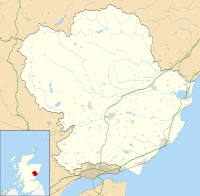Baikie Castle facts for kids
Quick facts for kids Baikie Castle |
|
|---|---|
| Angus, Scotland | |
| Coordinates | 56°37′51″N 3°06′45″W / 56.6307°N 3.1125°W |
| Site information | |
| Condition | No remains above ground |
| Site history | |
| Built | c. 13th century |
Baikie Castle was once a strong castle located in Angus, Scotland. It stood on the edge of what used to be a lake called Loch of Baikie. This castle was an important home for powerful families in Scotland many centuries ago.
Contents
What Was Baikie Castle?
Baikie Castle was a medieval (Middle Ages) fortress built around the 13th century. Castles like Baikie were not just homes; they were also defensive structures. They protected the people living inside from attacks.
Who Owned Baikie Castle?
The castle was first owned by the Fenton family. They were an important Scottish clan (a group of families with a common ancestor) who lived there for about 200 years, from the 1200s to the 1400s. After the Fenton family, the castle became the property of the Lyon of Glamis family. This family was also very powerful in Scotland.
How Was the Castle Protected?
Baikie Castle had several features to keep it safe from enemies. It was surrounded by a moat. A moat is a deep, wide ditch, usually filled with water, that goes all around a castle. This made it very hard for attackers to reach the castle walls. To get into Baikie Castle, people had to cross a drawbridge. A drawbridge is a movable bridge that could be pulled up to block the entrance. There was also a stone causeway, which was a raised path, providing another way to access the castle when the drawbridge was down.
What Happened to Baikie Castle?
Sadly, Baikie Castle no longer stands today. By the 1800s, there were no visible parts of the castle left above the ground. Many old castles in Scotland and other places have disappeared over time due to weather, people taking stones for other buildings, or simply falling into ruin. Even though the castle is gone, its history reminds us of the important families who lived there long ago.


